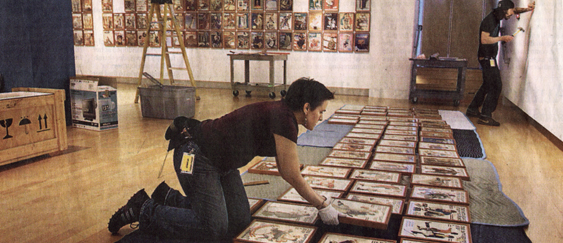As seen in the: THE NEWS TRIBUNE
By Rosemary Ponnekanti
Staff writer The News Tribune
Original paintings and magazine covers by the iconic 20th-century illustrator will fill Tacoma Art Museum’s two middle galleries beginning on Saturday, a 365-work traveling show from the Norman Rockwell Museum in Stockbridge, Mass., that has Tacoma as its only Northwest stop.
Why did TAM want Rockwell? The biggest reason is to celebrate its 75th anniversary. Tacoma Art Museum began life as the Tacoma Art Association on Oct. 23, 1935; from its beginnings in the tower of Jones Hall at the College of Puget Sound, the art organization evolved through various names and downtown locations, finally landing in its current building in 2003.
The actual anniversary date last fall was celebrated with 75-cent admission, an exhibition of the museum’s own collection of historic Japanese woodblock prints in “Edo to Tacoma,” as well as with the “Mighty Tacoma” photographic show. But TAM saved the big-ticket event for this month.
Another reason for choosing Rockwell is obvious: He’s popular, embodying an American zeitgeist that will likely draw big crowds.
Rockwell – who became a household name because of the decades he spent illustrating covers for magazines such as The Saturday Evening Post – is best known for his ruddy-cheeked, gently humorous depictions of ordinary Americans living quirky moments of their lives. His near-photographic exactitude and Everyman subjects gave him wide appeal through most of the 20th century, and in 1977, after 65 years of painting, he was awarded the Presidential Medal of Freedom.
But there’s another, less-obvious reason for the museum to host his show: He’s actually a pretty good painter.
“Rockwell is both familiar and surprising,” says TAM director Stephanie Stebich, who was the driving force behind choosing “American Chronicles: The Art of Norman Rockwell” for the museum’s anniversary. “He’s intergenerational – there are people who know Rockwell, and people who’ve just heard of Rockwell. But it’s time to re-evaluate him as an artist.”
One of the reasons Stebich wants Tacoma to take another look at Rockwell is to ask ourselves whether he really does reflect everyone’s idea of America.
“Rockwell asks the fundamental question, ‘What does it mean to be an American?’” says Stebich. “And not everyone agrees on the answer.”
A Bucolic Early Life
Rockwell certainly doesn’t embody the urban multicultural melting pot that is today’s America, despite the views on civil rights and Vietnam-era politics that are reflected in his later work.
Born in 1894 in New York City, he grew up in an artistic family that moved to the country when he was 13. He was inspired by reading Charles Dickens, by the quiet of the countryside, by experiences such as visiting the Met opera house and singing dutifully in a church choir. After making the cover of Boys’ Life magazine with his early paintings, Rockwell scored his job of illustrator for the Saturday Evening Post – which was to last most of his life – and drew on hometowns in Vermont and Massachusetts, as well as occasional travel, for inspiration.
The TAM show, on tour from the Norman Rockwell Museum in the artist’s town of Stockbridge, Mass., covers a huge swath of this work – some 42 paintings and 323 original magazine covers. You’ll see the mischievous boys of Rockwell’s own childhood in “No Swimming,” the Dickensian bonhomie of “Merrie Christmas,” the heartwarming Thanksgiving cliché of “Freedom From Want,” and the bold women of his life in “Brass Merchant.” There’s the well-known triple self-portrait of Rockwell painting himself with a mirror behind, and the feel-good scene with all his family in “Christmas Homecoming.”
But, as Stebich says, there are some surprises. Rockwell was greatly inspired by Old Masters such as Rembrandt and Drer, and you can see Rembrandt’s translucent light in “If Your Wisdom Teeth Could Talk…” He was a skillful draftsman who would meticulously plan out each full-sized oil painting for every magazine cover, even pasting over plain paper if an area needed redoing.
Margaret Bullock, the TAM curator who is ushering the show into the museum’s two mid-level galleries, is honest about how Rockwell’s original art took her by surprise.
“I had always thought, ‘Oh, he’s just an illustrator,’” she says. “I had only ever seen the magazine covers. Then I unpacked the real-life work and I thought, ‘Wow, this guy can really paint.’ He followed the Old Master teaching of over-glazing with lots of layers, so his paintings have this light quality. The color and detail are rich, with a great physical impact that takes the sentimental edge off the work.”
Changing Times
By the 1960s, Rockwell was well-known enough as an artist to start expressing more challenging political views.
In the exhibition are works such as “The Problem We All Live With” of a little African-American girl pelted with tomatoes as she is escorted to school by white U.S. field marshals, or “Murder in Mississippi,” inspired by a Pulitzer Prize-winning photograph of civil rights victims; both include studies showing the artistic process.
It was in this time that Rockwell’s art also started to question governmental policies in Vietnam, and made statements about peace, such as with the multi-racial, multi-religion harmony in “The Golden Rule.”
Despite this ambivalence, Stebich’s other reason for choosing this big-name show is that it will appeal to a part of the community the museum is dedicated to: the military.
“In works like the ‘Four Freedoms,’ Rockwell used images to rally the country during World War II,” she says. “I personally feel we haven’t done enough rallying to support people, whether you agree with the decisions or not.”
But for most visitors, “American Chronicles” – like Rockwell himself – won’t be anything really revolutionary.
Says Bullock, “It’s just a fun way to see this work in real life, and find out more about him.”


